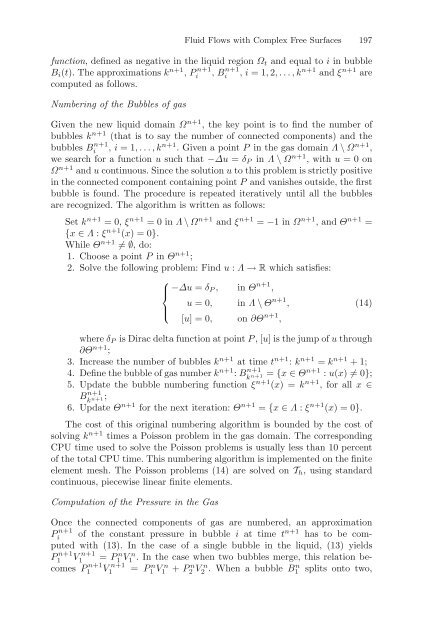Partial Differential Equations - Modelling and ... - ResearchGate
Partial Differential Equations - Modelling and ... - ResearchGate
Partial Differential Equations - Modelling and ... - ResearchGate
Create successful ePaper yourself
Turn your PDF publications into a flip-book with our unique Google optimized e-Paper software.
Fluid Flows with Complex Free Surfaces 197<br />
function, defined as negative in the liquid region Ω t <strong>and</strong> equal to i in bubble<br />
B i (t). The approximations k n+1 , P n+1<br />
i , B n+1<br />
i , i =1, 2,...,k n+1 <strong>and</strong> ξ n+1 are<br />
computed as follows.<br />
Numbering of the Bubbles of gas<br />
Given the new liquid domain Ω n+1 , the key point is to find the number of<br />
bubbles k n+1 (that is to say the number of connected components) <strong>and</strong> the<br />
bubbles B n+1<br />
i , i =1,...,k n+1 .GivenapointP in the gas domain Λ \ Ω n+1 ,<br />
we search for a function u such that −∆u = δ P in Λ \ Ω n+1 , with u =0on<br />
Ω n+1 <strong>and</strong> u continuous. Since the solution u to this problem is strictly positive<br />
in the connected component containing point P <strong>and</strong> vanishes outside, the first<br />
bubble is found. The procedure is repeated iteratively until all the bubbles<br />
are recognized. The algorithm is written as follows:<br />
Set k n+1 =0,ξ n+1 =0inΛ \ Ω n+1 <strong>and</strong> ξ n+1 = −1 inΩ n+1 ,<strong>and</strong>Θ n+1 =<br />
{x ∈ Λ : ξ n+1 (x) =0}.<br />
While Θ n+1 ≠ ∅, do:<br />
1. Choose a point P in Θ n+1 ;<br />
2. Solve the following problem: Find u : Λ → R which satisfies:<br />
⎧<br />
⎪⎨<br />
−∆u = δ P , in Θ n+1 ,<br />
u =0, in Λ \ Θ n+1 ,<br />
(14)<br />
⎪⎩<br />
[u] =0, on ∂Θ n+1 ,<br />
where δ P is Dirac delta function at point P ,[u] is the jump of u through<br />
∂Θ n+1 ;<br />
3. Increase the number of bubbles k n+1 at time t n+1 : k n+1 = k n+1 +1;<br />
4. Define the bubble of gas number k n+1 : B n+1<br />
k<br />
= {x ∈ Θ n+1 : u(x) ≠0};<br />
n+1<br />
5. Update the bubble numbering function ξ n+1 (x) =k n+1 , for all x ∈<br />
B n+1<br />
k<br />
; n+1<br />
6. Update Θ n+1 for the next iteration: Θ n+1 = {x ∈ Λ : ξ n+1 (x) =0}.<br />
The cost of this original numbering algorithm is bounded by the cost of<br />
solving k n+1 times a Poisson problem in the gas domain. The corresponding<br />
CPU time used to solve the Poisson problems is usually less than 10 percent<br />
of the total CPU time. This numbering algorithm is implemented on the finite<br />
element mesh. The Poisson problems (14) are solved on T h , using st<strong>and</strong>ard<br />
continuous, piecewise linear finite elements.<br />
Computation of the Pressure in the Gas<br />
Once the connected components of gas are numbered, an approximation<br />
P n+1<br />
i of the constant pressure in bubble i at time t n+1 has to be computed<br />
with (13). In the case of a single bubble in the liquid, (13) yields<br />
P1 n+1 V1 n+1 = P1 n V1 n . In the case when two bubbles merge, this relation becomes<br />
P1 n+1 V1 n+1 = P1 n V1 n + P2 n V2 n . When a bubble B1 n splits onto two,
















